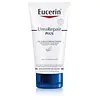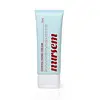What's inside
What's inside
 Key Ingredients
Key Ingredients

 Benefits
Benefits

 Concerns
Concerns

 Ingredients Side-by-side
Ingredients Side-by-side

Water
Skin ConditioningGlycerin
HumectantUrea
BufferingDibutyl Adipate
EmollientGlyceryl Stearate
EmollientStearyl Alcohol
EmollientDicaprylyl Ether
EmollientCetearyl Alcohol
EmollientSodium Lactate
BufferingTapioca Starch
Glyceryl Stearate Se
EmulsifyingCeramide NP
Skin ConditioningLactic Acid
BufferingArginine Hcl
Skin ConditioningSodium PCA
HumectantCholesterol
EmollientHelianthus Annuus Seed Oil
EmollientAlanine
MaskingCarnitine
CleansingGlycine
BufferingSodium Chloride
MaskingDimethicone
EmollientXanthan Gum
EmulsifyingSodium Cetearyl Sulfate
CleansingDecylene Glycol
Skin ConditioningPhenoxyethanol
PreservativePentylene Glycol
Skin ConditioningWater, Glycerin, Urea, Dibutyl Adipate, Glyceryl Stearate, Stearyl Alcohol, Dicaprylyl Ether, Cetearyl Alcohol, Sodium Lactate, Tapioca Starch, Glyceryl Stearate Se, Ceramide NP, Lactic Acid, Arginine Hcl, Sodium PCA, Cholesterol, Helianthus Annuus Seed Oil, Alanine, Carnitine, Glycine, Sodium Chloride, Dimethicone, Xanthan Gum, Sodium Cetearyl Sulfate, Decylene Glycol, Phenoxyethanol, Pentylene Glycol
Water
Skin ConditioningGlycerin
HumectantGlyceryl Stearate Citrate
EmollientCetearyl Alcohol
EmollientPanthenol
Skin ConditioningAllantoin
Skin ConditioningGlyceryl Stearate
EmollientSucrose Stearate
EmollientEthylhexyl Palmitate
EmollientGlycine Soja Oil
EmollientMel
EmollientVitis Vinifera Seed Oil
EmollientBenzyl Alcohol
PerfumingLimonene
PerfumingCaprylic/Capric Triglyceride
MaskingPassiflora Edulis Seed Oil
EmollientPunica Granatum Seed Oil
EmollientCitrus Paradisi Peel Oil
MaskingCitrus Aurantium Bergamia Peel Oil
Xanthan Gum
EmulsifyingSalix Alba Bark Extract
AstringentSalicylic Acid
MaskingCitrus Aurantium Amara Leaf/Twig Oil
MaskingLinalool
PerfumingTocopheryl Acetate
AntioxidantSorbic Acid
PreservativeSodium Hydroxide
BufferingGeraniol
PerfumingCitral
PerfumingWater, Glycerin, Glyceryl Stearate Citrate, Cetearyl Alcohol, Panthenol, Allantoin, Glyceryl Stearate, Sucrose Stearate, Ethylhexyl Palmitate, Glycine Soja Oil, Mel, Vitis Vinifera Seed Oil, Benzyl Alcohol, Limonene, Caprylic/Capric Triglyceride, Passiflora Edulis Seed Oil, Punica Granatum Seed Oil, Citrus Paradisi Peel Oil, Citrus Aurantium Bergamia Peel Oil, Xanthan Gum, Salix Alba Bark Extract, Salicylic Acid, Citrus Aurantium Amara Leaf/Twig Oil, Linalool, Tocopheryl Acetate, Sorbic Acid, Sodium Hydroxide, Geraniol, Citral
 Reviews
Reviews

Ingredients Explained
These ingredients are found in both products.
Ingredients higher up in an ingredient list are typically present in a larger amount.
Cetearyl alcohol is a mixture of two fatty alcohols: cetyl alcohol and stearyl alcohol. It is mainly used as an emulsifier. Emulsifiers help prevent the separation of oils and products. Due to its composition, it can also be used to thicken a product or help create foam.
Cetearyl alcohol is an emollient. Emollients help soothe and hydrate the skin by trapping moisture.
Studies show Cetearyl alcohol is non-toxic and non-irritating. The FDA allows products labeled "alcohol-free" to have fatty alcohols.
This ingredient is usually derived from plant oils such as palm, vegetable, or coconut oils. There is debate on whether this ingredient will cause acne.
Due to the fatty acid base, this ingredient may not be Malassezia folliculitis safe.
Learn more about Cetearyl AlcoholGlycerin is already naturally found in your skin. It helps moisturize and protect your skin.
A study from 2016 found glycerin to be more effective as a humectant than AHAs and hyaluronic acid.
As a humectant, it helps the skin stay hydrated by pulling moisture to your skin. The low molecular weight of glycerin allows it to pull moisture into the deeper layers of your skin.
Hydrated skin improves your skin barrier; Your skin barrier helps protect against irritants and bacteria.
Glycerin has also been found to have antimicrobial and antiviral properties. Due to these properties, glycerin is often used in wound and burn treatments.
In cosmetics, glycerin is usually derived from plants such as soybean or palm. However, it can also be sourced from animals, such as tallow or animal fat.
This ingredient is organic, colorless, odorless, and non-toxic.
Glycerin is the name for this ingredient in American English. British English uses Glycerol/Glycerine.
Learn more about GlycerinGlyceryl Stearate is a mix of glycerin and stearic acid.
It is used to stabilize the mixing of water and oil ingredients. By preventing these ingredients from separating, it can help elongate shelf life. It can also help thicken the product's texture.
As an emollient, it helps soften skin and supports barrier-replenishing ingredients.
In cosmetics, Glyceryl Stearate is often made from vegetable oils or synthetically produced.
This ingredient may not be fungal-acne safe
Fun fact: The human body also creates Glyceryl Stearate naturally.
Learn more about Glyceryl StearateWater. It's the most common cosmetic ingredient of all. You'll usually see it at the top of ingredient lists, meaning that it makes up the largest part of the product.
So why is it so popular? Water most often acts as a solvent - this means that it helps dissolve other ingredients into the formulation.
You'll also recognize water as that liquid we all need to stay alive. If you see this, drink a glass of water. Stay hydrated!
Learn more about WaterXanthan gum is used as a stabilizer and thickener within cosmetic products. It helps give products a sticky, thick feeling - preventing them from being too runny.
On the technical side of things, xanthan gum is a polysaccharide - a combination consisting of multiple sugar molecules bonded together.
Xanthan gum is a pretty common and great ingredient. It is a natural, non-toxic, non-irritating ingredient that is also commonly used in food products.
Learn more about Xanthan Gum